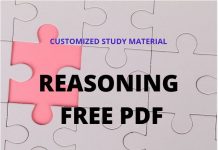 For Daily Job Alert For Daily Job Alert |
Join Our Whats App Channel |
 For Free Study Material For Free Study Material |
Join Our Telegram Channel |
Directions (1-10): Each of the questions below consists of a question and two statements numbered I and II given below it. You have to decide whether the data provided in the statements are sufficient to answer the question.
Read the question and both the statements and choose
(1) if the data in statement I alone are sufficient to answer the question, while the data in statement II alone are not sufficient to ansswer the question.
(2) if the data in statement II alone are sufficient to answer the question, while the data in statement I alone are not sufficient to answer the question.
(3) if the data either in statement I alone or in statement II alone are sufficient to answer the question.
(4) if the data even in both the statements I and II together are not sufficient to answer the question.
(5) if the data in both the statements I and II together are necessary to answer the question
1. Train ‘A’ running at a certain speed crosses another train ‘B’ running at a certain speed in the opposite direction in 12 seconds. What is the length of train ‘B’ ?
I. The length of both the trains together is 450 metres.
II. Train ‘A’ is slower than train ‘B’.
2. Area of a rectangle is equal to the area of a right angled triangle. What is the length of the rectangle ?
I. The base of the triangle is 40 cms.
II. The height of the triangle is 50 cms.
3. What was the total compound interest on a sum after three years ?
I. The interest after one year was Rs. 100/ and the sum was Rs. 1,000/-.
II. The difference between simple and compound interest on a sum of Rs. 1,000/- at the end of two years was Rs. 10/-.
4. What is the two digit number where the digit at the unit place is smaller ?
I. The difference between the two digits is 5.
II. The sum of the two digits is 7.
5. What is the speed of the boat in still water ?
I. It takes 2 hours to cover distance between A and B downstreams.
II. It takes 4 hours to cover distance between A and B upstreams
6. What is the annual income of Mr. Krishnamurthy form April 2001 to March 2002 ?
I. The annual income of Mr. Krishnamurthy is 70% more than that of his boss.
II. In April 2001 the income of Krishnamurthy was Rs. 12000 and his income increases by 10% per month.
7. What is the area of circular field ?
I. The circumference of the field is x metres.
II. The diameter of the field is y metres.
8. What is the speed of boat in still water ?
I. The boat covers a distance of 35 kms in 5 hours in downstream.
II. The boat takes 7 hours to cover the same distance in upstream.
9. How many students are there in the class ?
I. The ratio between the number of boys and girls is 5 : 6 respectively.
II. The difference between the numbers of boys and girls is 7.
10. What is the amount of earned profit ?
I. On selling the article for Rs. 1740, 20% profit is earned.
II. The cost price ofthe article is Rs. 1400.
Directions (11-15) : In each of the following questions, a question is followed by information given in three statements. You have to study the question along with the statements and decide, the information given in which of the statement(s) is necessary to answer the question.
11. In how many days can 16 men and 8 women together complete the piece of work ?
I. 8 men complete the piece of work in 10 days.
II. 16 women complete the piece of work in 10 days.
III. 5 women take 32 days to complete the piece of work.
(1) Only I and II
(2) Only I and III
(3) Only II and III
(4) Only I and either II or III
(5) Any two of the three
12. What is the speed of the train ?
I. Train crosses a pole in 10 seconds
II. Length of the train is 240 metres.
III. Train crosses a platform of equal length in 20 seconds.
(1) Only I and II
(2) Only II and III
(3) All I, II and III
(4) Any two of the three
(5) II and either I or III
13. What is the area of the square ?
I. Measure of diagonal of the square is given.
II. Measure of one side of square is given.
III. Perimeter of the square is given.
(1) Only II
(2) Only III
(3) Only I and III
(4) Only II and III
(5) Any one of the three
14. What is the two digit number ?
I. The number obtained by interchanging the digits of the number is greater than the original number by 18.
II. Sum of the two digits of the number is 14.
III. Difference between the two digits of the number is 2.
(1) Any two of the three
(2) Only I and III
(3) II and either I or III
(4) All the three
(5) III and either I or II
15. What is the rate of interest p.c.p.a. ?
I. Simple interest earned per annum is Rs. 5,300
II. The difference between the compound and simple interest on an amount is Rs. 1,060 at the end of 2 years.
III. An amount doubles itself in 5 years with simple interest.
(1) All the three
(2) Only III
(3) Either II or III
(4) Only III or I and II
(5) Question cannot be answered even with the information in all three statements












